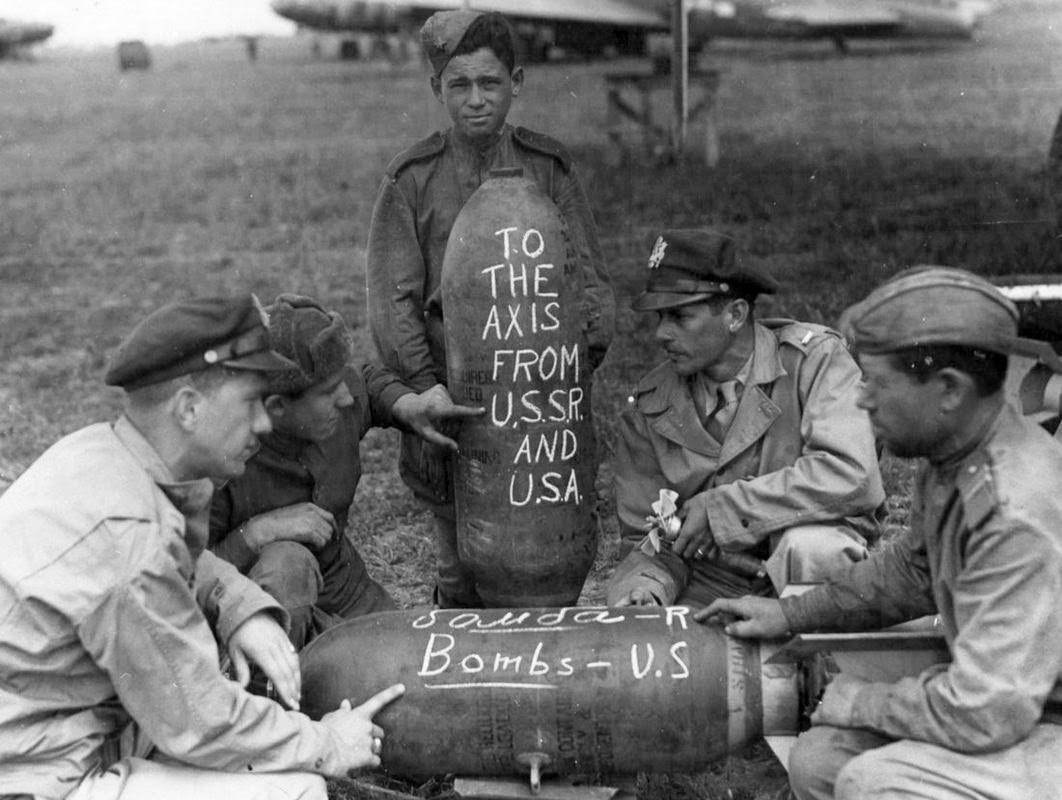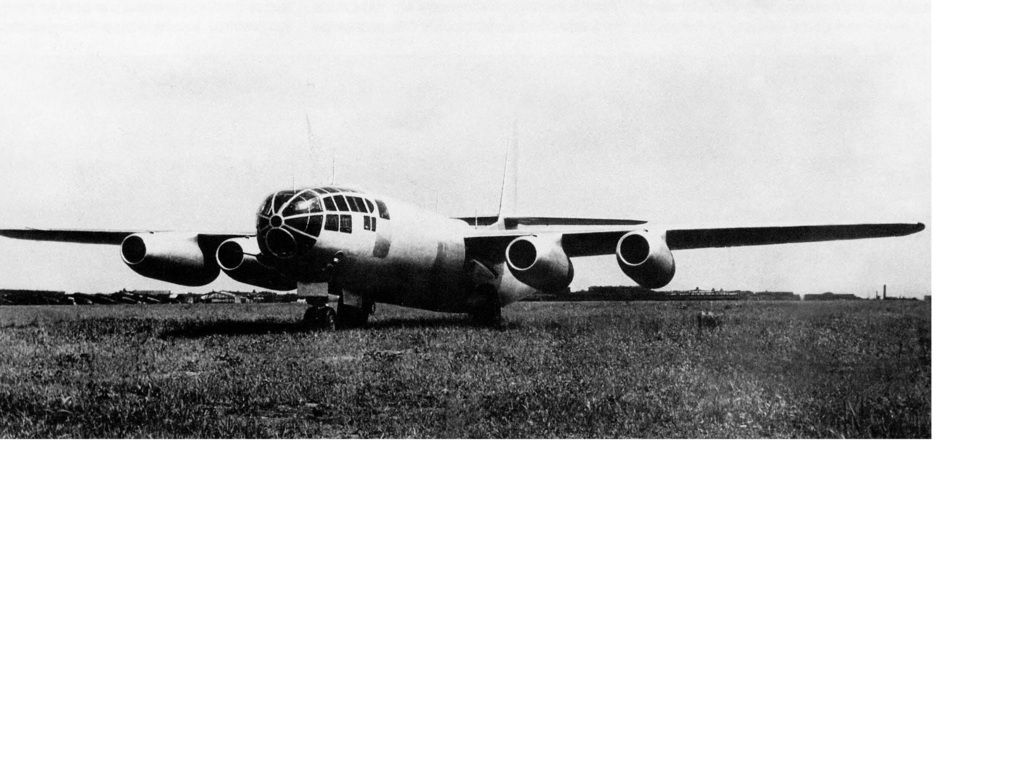Estás usando un navegador obsoleto. No se pueden mostrar estos u otros sitios web correctamente.
Se debe actualizar o usar un navegador alternativo.
Se debe actualizar o usar un navegador alternativo.
Fotos inéditas y difíciles < fotos >
- Tema iniciado Athos80
- Fecha de inicio
he Soviet Airborne & Disembarking the Tupolev TB-3
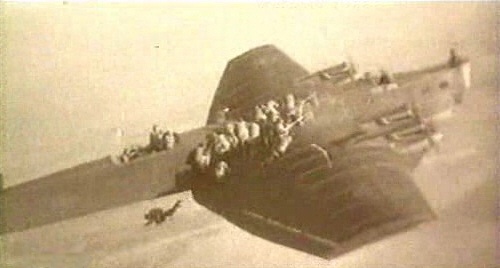 By HistoricalFirearms.info.
By HistoricalFirearms.info.
The photographs below show the rather unusual method of how Russian Paratroopers disembarked from the TB-3. By jumping or rather sliding from the wing. The Soviets were one of the first countries to take the concept of airborne infantry seriously developing the tactic during the 1930s.

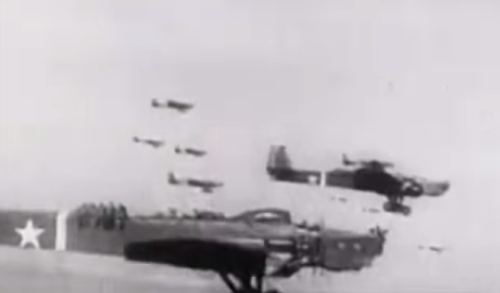
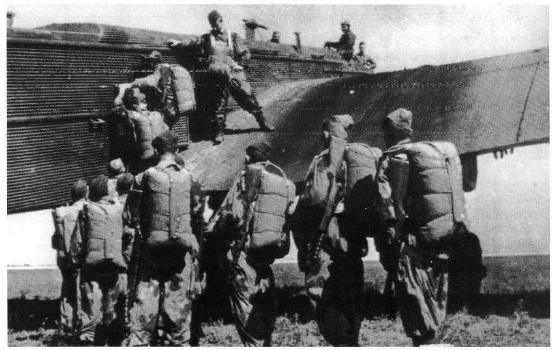 The Tupolev TB-3 was initially designed as a heavy bomber capable of carrying 4,000 lbs of bombs. It entered production in 1930, by the mid 1930s the TB-3had also taken on the air transport role for the new Russian Airborne units capable of carrying up to 35 paratroops.
The Tupolev TB-3 was initially designed as a heavy bomber capable of carrying 4,000 lbs of bombs. It entered production in 1930, by the mid 1930s the TB-3had also taken on the air transport role for the new Russian Airborne units capable of carrying up to 35 paratroops.

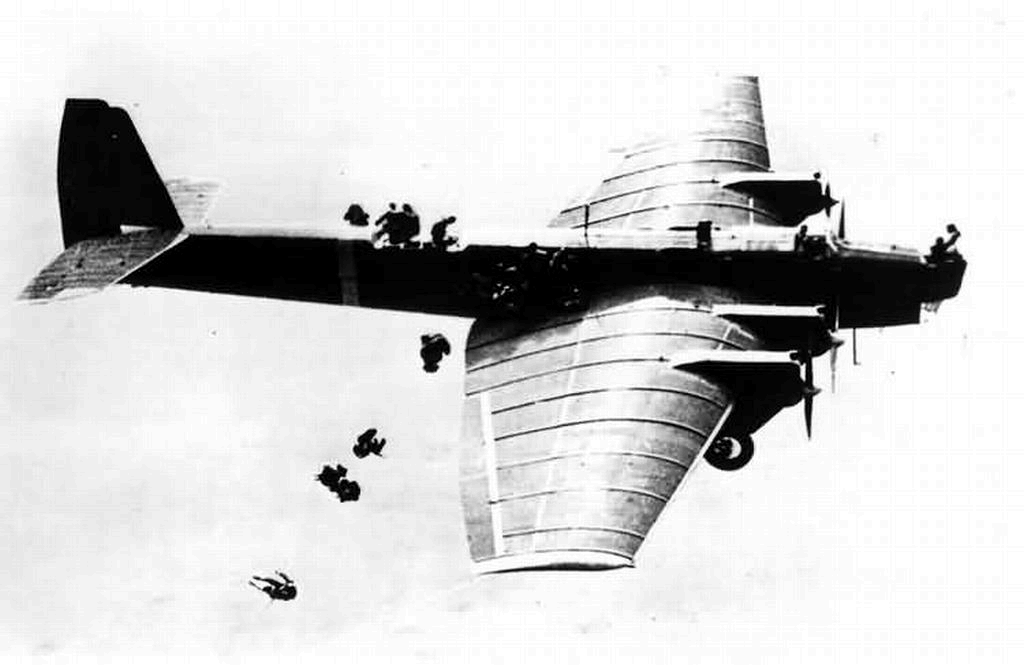
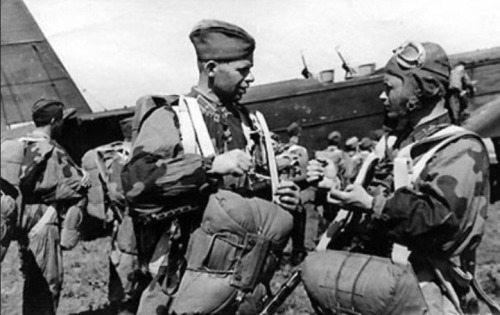
The paratroopers boarded through a side hatch and travelled in the plane’s fuselage while the flight crew and gunners operated in exposed cockpits on the top of the aircraft. Once over their dropzone the parachutists would disembark by climbing up out of the top of the fuselage, dropping themselves down onto the plane’s wing and then sliding off. They would wait until most of the men were on the wing before jumping in order to minimise drop zone dispersion.

Squadron of Soviet transports carrying paratroops (source)
During the interwar period development and experimentation with parachute troops was patchy with Britain, France and the United States ignoring the concept while Russia, Italy and Poland embraced the idea. In the Soviet Union parachuting became a national sport with thousands of Russians jumping from planes and parachute towers erected in towns across the country.
Marshal Mikhail Tukhachevsky led the push for airborne units, he was an exponent of ‘Deep Operations’ theorising that a rapid strike at the enemy’s rear and lines of communication with air-landed and parachute troops could knock the enemy off balance. In 1931, Tukhachevsky tested his theories with a trial drop of eleven armed paratroops from a Tupolev ANT-9 passenger plane who then simulated attack on an enemy headquarters.


Soviet Paratroops prepare to for a jump (#1 source & #2 source)
The soviets continued to support the development of parachute forces within their aviation brigades during the early 1930s . They refined their tactics in hundreds of airborne exercises with special parachute detachments tasked with capturing airstrips in order for larger elements to land – a tactic the German Fallschirmjäger’s would adopt. In December 1932, the 3rd Airlanding Brigade (Special Purpose) with a dedicated battalion of paratroops was formed and a further 29 battalions numbering 8,000 paratroops in total were formed in 1933. In addition to experimentation with paratroops glider-borne forces were also developed. In 1934 the Red Army boasted ten glider manufacturing plants with 230 glider stations, and 57,000 trained glider pilots.

Paratroops jump from three Tupolev TB-3s (source)
In September 1935 major Soviet exercises near Kiev demonstrated to Western military observers just how far Soviet airborne warfare had been developed. A U.S. observer Major Faymonvillereported that 1,800 paratroops jumped simultaneously with weapons and ammunition and formed a defensive strongpoint behind a simulated enemies lines to be relieved by a Soviet tank column. The British observer at the exercise, Major General Archibald Wavell, was unimpressed by the demonstration: “this parachute descent, though its tactical value may be doubtful, was a most spectacular performance.” Wavellprophetically believed that the time it took lightly armed paratroops to concentrate on the ground could prove disastrous. However, one country which was universally impressed by the demonstration was Germany.
When we’re used to seeing paratroopers jump from side doors or from rear ramps it is an unusual sight to see them sliding off the wing. But when you consider that previous parachute jumps made by individuals had been made by pilots climbing from the cockpit the logic of sliding from the plane can be seen. The Soviets were not alone in their unique methods of jumping. During the early years of World War Two British Airborne troops dropped from a small hole in the underside of Armstrong Whitworth Whitley bombers.
Russian Airborne troops made relatively few combat jumps, of the numerous Airborne Brigades formed most were hastily thrown into the line as infantry when Germany invaded in 1941. With most of the original Soviet Paratroops killed in the first months of the war it wasn’t until the mid 1940s that any jumps were made. The Tupolev TB-3 remained a workhorse of the hard pressed Soviet air force during the war even though it was obsolete and had officially been retired before the beginning of the war.
 By HistoricalFirearms.info.
By HistoricalFirearms.info. The photographs below show the rather unusual method of how Russian Paratroopers disembarked from the TB-3. By jumping or rather sliding from the wing. The Soviets were one of the first countries to take the concept of airborne infantry seriously developing the tactic during the 1930s.


 The Tupolev TB-3 was initially designed as a heavy bomber capable of carrying 4,000 lbs of bombs. It entered production in 1930, by the mid 1930s the TB-3had also taken on the air transport role for the new Russian Airborne units capable of carrying up to 35 paratroops.
The Tupolev TB-3 was initially designed as a heavy bomber capable of carrying 4,000 lbs of bombs. It entered production in 1930, by the mid 1930s the TB-3had also taken on the air transport role for the new Russian Airborne units capable of carrying up to 35 paratroops.




Squadron of Soviet transports carrying paratroops (source)
During the interwar period development and experimentation with parachute troops was patchy with Britain, France and the United States ignoring the concept while Russia, Italy and Poland embraced the idea. In the Soviet Union parachuting became a national sport with thousands of Russians jumping from planes and parachute towers erected in towns across the country.
Marshal Mikhail Tukhachevsky led the push for airborne units, he was an exponent of ‘Deep Operations’ theorising that a rapid strike at the enemy’s rear and lines of communication with air-landed and parachute troops could knock the enemy off balance. In 1931, Tukhachevsky tested his theories with a trial drop of eleven armed paratroops from a Tupolev ANT-9 passenger plane who then simulated attack on an enemy headquarters.


Soviet Paratroops prepare to for a jump (#1 source & #2 source)
The soviets continued to support the development of parachute forces within their aviation brigades during the early 1930s . They refined their tactics in hundreds of airborne exercises with special parachute detachments tasked with capturing airstrips in order for larger elements to land – a tactic the German Fallschirmjäger’s would adopt. In December 1932, the 3rd Airlanding Brigade (Special Purpose) with a dedicated battalion of paratroops was formed and a further 29 battalions numbering 8,000 paratroops in total were formed in 1933. In addition to experimentation with paratroops glider-borne forces were also developed. In 1934 the Red Army boasted ten glider manufacturing plants with 230 glider stations, and 57,000 trained glider pilots.

Paratroops jump from three Tupolev TB-3s (source)
In September 1935 major Soviet exercises near Kiev demonstrated to Western military observers just how far Soviet airborne warfare had been developed. A U.S. observer Major Faymonvillereported that 1,800 paratroops jumped simultaneously with weapons and ammunition and formed a defensive strongpoint behind a simulated enemies lines to be relieved by a Soviet tank column. The British observer at the exercise, Major General Archibald Wavell, was unimpressed by the demonstration: “this parachute descent, though its tactical value may be doubtful, was a most spectacular performance.” Wavellprophetically believed that the time it took lightly armed paratroops to concentrate on the ground could prove disastrous. However, one country which was universally impressed by the demonstration was Germany.
When we’re used to seeing paratroopers jump from side doors or from rear ramps it is an unusual sight to see them sliding off the wing. But when you consider that previous parachute jumps made by individuals had been made by pilots climbing from the cockpit the logic of sliding from the plane can be seen. The Soviets were not alone in their unique methods of jumping. During the early years of World War Two British Airborne troops dropped from a small hole in the underside of Armstrong Whitworth Whitley bombers.
Russian Airborne troops made relatively few combat jumps, of the numerous Airborne Brigades formed most were hastily thrown into the line as infantry when Germany invaded in 1941. With most of the original Soviet Paratroops killed in the first months of the war it wasn’t until the mid 1940s that any jumps were made. The Tupolev TB-3 remained a workhorse of the hard pressed Soviet air force during the war even though it was obsolete and had officially been retired before the beginning of the war.
Drought sheds new light on the B-29 wreckage in Lake Mead

Lake Mead has been hitting records lows throughout the year, raising the specter of water cutbacks for Arizona and Nevada in the near future.The upshot for these scuba divers: the underwater wreckage is easier to explore, as Silverstein explained on the boat ride out. “On its crash, it sank in approximately 260 feet of water and that’s exceptionally deep for scuba diving,” Brown said.
Scroll down for video
Now it’s less than 130 feet down, meaning more light and divers need less training. Silverstein has gone wreck diving all over the world and said the B-29 stands out. For one, the cool freshwater has kept the plane in remarkably good condition. “That plane has never seen air since 1948. Everything in there, every control that’s inside it, is in its original position,” Silverstein said.
Soon, the crew is wriggling into heavy insulated wetsuits, fastening straps and straddling tanks of nitrox. By the end they look like astronauts, not out of place in the moonscape of Lake Mead.John Fuller is the boat’s captain and one of the tour guides. Bobbing in the water, he gave Steve Brown a “dry run” before the descent.
“Then we’ll go around to the second place where the engine used to be,” Fuller said. “And look at the gigantic hole with all the pipes and tubes and wires and all the stuff. You’re thinking, ‘man, who designed something like that?’” At the time of its inception during World War II, the B-29 was a major leap forward for American military aviation. It could carry out bombing campaigns in the Pacific and was eventually entrusted with nuclear weapons.
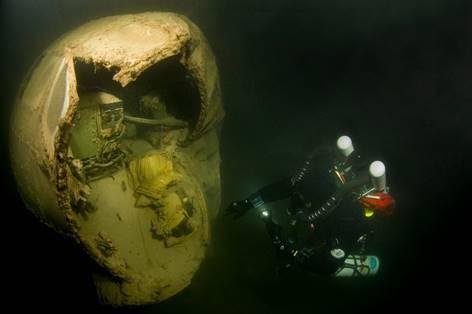
An old military training video from the time described it as, “The plane you’ve been for and it was worth
for and it was worth  for. It’s the biggest, fastest, mightiest heavy bomber in the world.” Only one operational B-29 remains in the world today. From video below, you can make out the propellers lodged into the silty bottom, the cracked fuselage caked in mussels and the cockpit with the remains of a parachute, aglow in green murky light.
for. It’s the biggest, fastest, mightiest heavy bomber in the world.” Only one operational B-29 remains in the world today. From video below, you can make out the propellers lodged into the silty bottom, the cracked fuselage caked in mussels and the cockpit with the remains of a parachute, aglow in green murky light.
Eventually, the divers resurfaced, Adam Christopher among them. “We came upon the tail and then went around the port side, around the wing to the only remaining propeller, which is also quite large, but it’s bent as though it hit the water,” explained Christopher, still out of breath from the ascent.
Since the plane was discovered in the early 2000s, the National Park Service and only about 60 people have dived the bomber, said Silverstein. There aren’t plans to pull it out of the water anytime soon, either. According to the National Oceanographic and Atmospheric Administration, the B-29 was one of the last built and was delivered to the U.S. Army eleven days after the end of World War II.
Stripped of armaments, it became a post-war reconnaissance plane used in an upper atmospheric research program based at Muroc Army Airfield in California. “Part of this research was focused on the development of a device that used the sun as a point of reference to guide missiles as they arched from the United States towards the Soviet Union,” NOAA said. On July 21, 1948, the plane was being flown on a mission to test a secret missile guidance system. While descending over the smooth-as-glass lake, the pilot lost depth perception and flew the bomber into the water at 230 mph. It skipped once, settled onto the surface and sank. All five crew members survived, but the bomber was lost until August 2001, when a team of local divers discovered it sitting upright and mostly intact on the lake bottom.
Image@Mel Clark

Lake Mead has been hitting records lows throughout the year, raising the specter of water cutbacks for Arizona and Nevada in the near future.The upshot for these scuba divers: the underwater wreckage is easier to explore, as Silverstein explained on the boat ride out. “On its crash, it sank in approximately 260 feet of water and that’s exceptionally deep for scuba diving,” Brown said.
Scroll down for video
Now it’s less than 130 feet down, meaning more light and divers need less training. Silverstein has gone wreck diving all over the world and said the B-29 stands out. For one, the cool freshwater has kept the plane in remarkably good condition. “That plane has never seen air since 1948. Everything in there, every control that’s inside it, is in its original position,” Silverstein said.
Soon, the crew is wriggling into heavy insulated wetsuits, fastening straps and straddling tanks of nitrox. By the end they look like astronauts, not out of place in the moonscape of Lake Mead.John Fuller is the boat’s captain and one of the tour guides. Bobbing in the water, he gave Steve Brown a “dry run” before the descent.
“Then we’ll go around to the second place where the engine used to be,” Fuller said. “And look at the gigantic hole with all the pipes and tubes and wires and all the stuff. You’re thinking, ‘man, who designed something like that?’” At the time of its inception during World War II, the B-29 was a major leap forward for American military aviation. It could carry out bombing campaigns in the Pacific and was eventually entrusted with nuclear weapons.

An old military training video from the time described it as, “The plane you’ve been
 for and it was worth
for and it was worth  for. It’s the biggest, fastest, mightiest heavy bomber in the world.” Only one operational B-29 remains in the world today. From video below, you can make out the propellers lodged into the silty bottom, the cracked fuselage caked in mussels and the cockpit with the remains of a parachute, aglow in green murky light.
for. It’s the biggest, fastest, mightiest heavy bomber in the world.” Only one operational B-29 remains in the world today. From video below, you can make out the propellers lodged into the silty bottom, the cracked fuselage caked in mussels and the cockpit with the remains of a parachute, aglow in green murky light.Eventually, the divers resurfaced, Adam Christopher among them. “We came upon the tail and then went around the port side, around the wing to the only remaining propeller, which is also quite large, but it’s bent as though it hit the water,” explained Christopher, still out of breath from the ascent.
Since the plane was discovered in the early 2000s, the National Park Service and only about 60 people have dived the bomber, said Silverstein. There aren’t plans to pull it out of the water anytime soon, either. According to the National Oceanographic and Atmospheric Administration, the B-29 was one of the last built and was delivered to the U.S. Army eleven days after the end of World War II.
Stripped of armaments, it became a post-war reconnaissance plane used in an upper atmospheric research program based at Muroc Army Airfield in California. “Part of this research was focused on the development of a device that used the sun as a point of reference to guide missiles as they arched from the United States towards the Soviet Union,” NOAA said. On July 21, 1948, the plane was being flown on a mission to test a secret missile guidance system. While descending over the smooth-as-glass lake, the pilot lost depth perception and flew the bomber into the water at 230 mph. It skipped once, settled onto the surface and sank. All five crew members survived, but the bomber was lost until August 2001, when a team of local divers discovered it sitting upright and mostly intact on the lake bottom.
Image@Mel Clark
Flettner Fl 282 Kolibri
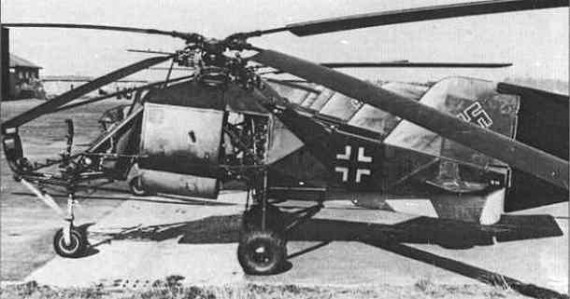
The Flettner Fl 282 Kolibri (“Hummingbird”) is a single-seat open cockpit intermeshing rotor helicopter, or synchropter, produced by Anton Flettner of Germany. According to Yves Le Bec, the Flettner Fl 282 was the world’s first series production helicopter.
Intended roles of Fl 282 included ferrying items between ships and reconnaissance. However, as the war progressed, the Luftwaffe began considering converting the Fl 282 for battlefield use. Until this time the craft had been flown by a single pilot, but by then a position for an observer was added at the very rear of the craft, resulting in the B-2 version. Later the B-2 proved a useful artillery spotting aircraft and an observation unit was established in 1945 comprising three Fl 282 and three Fa 223 helicopters.
Good handling in bad weather led the German Air Ministry to issue a contract in 1944 to BMW to produce 1,000 units. However, the company’s Munich plant was destroyed by Allied bombing raids after producing just 24 machines.
Towards the end of World War II most of the surviving Fl 282s were stationed at Rangsdorf, in their role as artillery spotters, but gradually fell victim to Soviet fighters and anti-aircraft fire

The Flettner Fl 282 Kolibri (“Hummingbird”) is a single-seat open cockpit intermeshing rotor helicopter, or synchropter, produced by Anton Flettner of Germany. According to Yves Le Bec, the Flettner Fl 282 was the world’s first series production helicopter.
Intended roles of Fl 282 included ferrying items between ships and reconnaissance. However, as the war progressed, the Luftwaffe began considering converting the Fl 282 for battlefield use. Until this time the craft had been flown by a single pilot, but by then a position for an observer was added at the very rear of the craft, resulting in the B-2 version. Later the B-2 proved a useful artillery spotting aircraft and an observation unit was established in 1945 comprising three Fl 282 and three Fa 223 helicopters.
Good handling in bad weather led the German Air Ministry to issue a contract in 1944 to BMW to produce 1,000 units. However, the company’s Munich plant was destroyed by Allied bombing raids after producing just 24 machines.
Towards the end of World War II most of the surviving Fl 282s were stationed at Rangsdorf, in their role as artillery spotters, but gradually fell victim to Soviet fighters and anti-aircraft fire
Hans-Ulrich Rudel
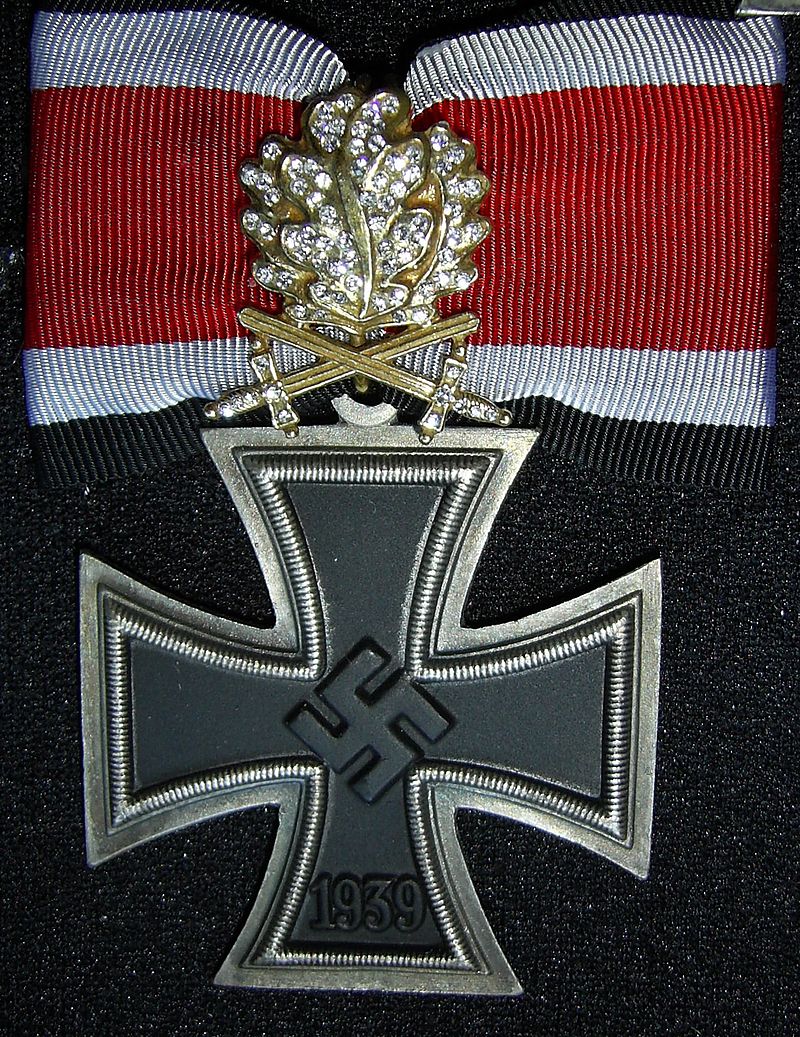
AwardsHonour Goblet of the Luftwaffe (Ehrenpokal der Luftwaffe) as Oberleutnant in a Sturzkampfgeschwader (20 October 1941)
Wound Badge in Gold
Pilot/Observer Badge in Gold with Diamonds
German Cross in Gold on 2 December 1941 as Oberleutnant in the III./Sturzkampfgeschwader 2[7]
Iron Cross (1939)
2nd Class (10 November 1939)
1st Class (18 July 1941)
Front Flying Clasp of the Luftwaffe in Gold and Diamonds with Pennant “2000”
in Gold (18 July 1941)
in Gold and Diamonds with Pennant “2000”
Knight’s Cross of the Iron Cross with Golden Oak Leaves, Swords and Diamonds
Knight’s Cross on 6 January 1942 as Oberleutnant and Staffelkapitän of the 9./Sturzkampfgeschwader 2 “Immelmann”
229th Oak Leaves on 14 April 1943 as Oberleutnant and Staffelkapitän of the 1./Sturzkampfgeschwader 2 “Immelmann”
42nd Swords on 25 November 1943 as Hauptmann and leader of the III./Sturzkampfgeschwader 2 “Immelmann”
10th Diamonds on 29 March 1944 as Major and Gruppenkommandeur of the III./Schlachtgeschwader 2 “Immelmann”
1st Golden Oak Leaves on 29 December 1944 as Oberstleutnant and Geschwaderkommodore of Schlachtgeschwader 2 “Immelmann”
8th (1st and only foreign) Hungarian Gold Medal of Bravery (14 January 1945)

AwardsHonour Goblet of the Luftwaffe (Ehrenpokal der Luftwaffe) as Oberleutnant in a Sturzkampfgeschwader (20 October 1941)
Wound Badge in Gold
Pilot/Observer Badge in Gold with Diamonds
German Cross in Gold on 2 December 1941 as Oberleutnant in the III./Sturzkampfgeschwader 2[7]
Iron Cross (1939)
2nd Class (10 November 1939)
1st Class (18 July 1941)
Front Flying Clasp of the Luftwaffe in Gold and Diamonds with Pennant “2000”
in Gold (18 July 1941)
in Gold and Diamonds with Pennant “2000”
Knight’s Cross of the Iron Cross with Golden Oak Leaves, Swords and Diamonds
Knight’s Cross on 6 January 1942 as Oberleutnant and Staffelkapitän of the 9./Sturzkampfgeschwader 2 “Immelmann”
229th Oak Leaves on 14 April 1943 as Oberleutnant and Staffelkapitän of the 1./Sturzkampfgeschwader 2 “Immelmann”
42nd Swords on 25 November 1943 as Hauptmann and leader of the III./Sturzkampfgeschwader 2 “Immelmann”
10th Diamonds on 29 March 1944 as Major and Gruppenkommandeur of the III./Schlachtgeschwader 2 “Immelmann”
1st Golden Oak Leaves on 29 December 1944 as Oberstleutnant and Geschwaderkommodore of Schlachtgeschwader 2 “Immelmann”
8th (1st and only foreign) Hungarian Gold Medal of Bravery (14 January 1945)
Temas similares
- Respuestas
- 66
- Visitas
- 3K
- Respuestas
- 113
- Visitas
- 6K
- Respuestas
- 137
- Visitas
- 7K
- Respuestas
- 312
- Visitas
- 19K
- Respuestas
- 249
- Visitas
- 12K











